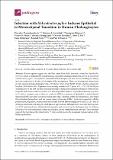Infection with Helicobacter pylori Induces Epithelial to Mesenchymal Transition in Human Cholangiocytes
Author(s)
Thanaphongdecha, Prissadee; Karinshak, Shannon E.; Ittiprasert, Wannaporn; Mann, Victoria H.; Chamgramol, Yaovalux; Pairojkul, Chawalit; Fox, James G.; Suttiprapa, Sutas; Sripa, Banchob; Brindley, Paul J.; ... Show more Show less
Downloadpathogens-09-00971-v2.pdf (2.592Mb)
Publisher with Creative Commons License
Publisher with Creative Commons License
Creative Commons Attribution
Terms of use
Metadata
Show full item recordAbstract
Recent reports suggest that the East Asian liver fluke infection, caused by <i>Opisthorchis viverrini</i>, which is implicated in opisthorchiasis-associated cholangiocarcinoma, serves as a reservoir of <i>Helicobacter pylori</i>. The opisthorchiasis-affected cholangiocytes that line the intrahepatic biliary tract are considered to be the cell of origin of this malignancy. Here, we investigated interactions in vitro among human cholangiocytes, <i>Helicobacter pylori</i> strain NCTC 11637, and the congeneric bacillus, <i>Helicobacter bilis</i>. Exposure to increasing numbers of <i>H. pylori</i> at 0, 1, 10, 100 bacilli per cholangiocyte of the H69 cell line induced phenotypic changes including the profusion of thread-like filopodia and a loss of cell-cell contact, in a dose-dependent fashion. In parallel, following exposure to <i>H. pylori</i>, changes were evident in levels of mRNA expression of epithelial to mesenchymal transition (EMT)-encoding factors including snail, slug, vimentin, matrix metalloprotease, zinc finger E-box-binding homeobox, and the cancer stem cell marker CD44. Analysis to quantify cellular proliferation, migration, and invasion in real-time by both H69 cholangiocytes and CC-LP-1 line of cholangiocarcinoma cells using the xCELLigence approach and Matrigel matrix revealed that exposure to ≥10 <i>H. pylori</i> bacilli per cell stimulated migration and invasion by the cholangiocytes. In addition, 10 bacilli of <i>H. pylori</i> stimulated contact-independent colony establishment in soft agar. These findings support the hypothesis that infection by <i>H.</i><i>pylori</i> contributes to the malignant transformation of the biliary epithelium.
Date issued
2020-11-21Department
Massachusetts Institute of Technology. Division of Comparative MedicinePublisher
Multidisciplinary Digital Publishing Institute
Citation
Pathogens 9 (11): 971 (2020)
Version: Final published version